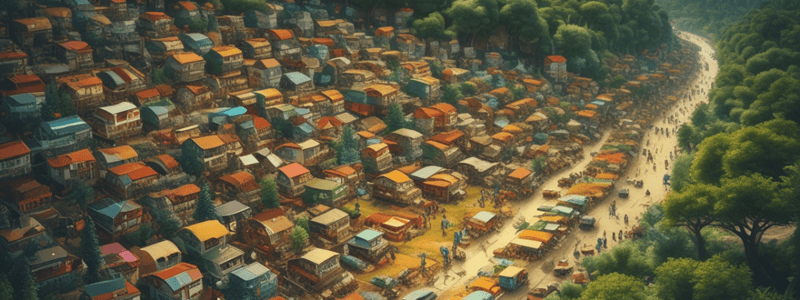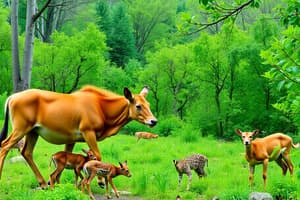Podcast
Questions and Answers
What is the key concept of exponential growth?
What is the key concept of exponential growth?
- Population size remains constant over time
- The growth rate remains constant over time
- The population size increases at a constant rate
- The growth rate increases over time (correct)
What term is used to describe the maximum population size that a particular environment can sustain?
What term is used to describe the maximum population size that a particular environment can sustain?
- Growth capacity
- Carrying capacity (correct)
- Expansion threshold
- Reproductive limit
In logistic growth, what happens to the growth rate as resources become scarce?
In logistic growth, what happens to the growth rate as resources become scarce?
- It decreases (correct)
- It remains constant
- It fluctuates
- It increases
What type of growth curve is produced when resources are limited?
What type of growth curve is produced when resources are limited?
What occurs when a population overshoots its carrying capacity?
What occurs when a population overshoots its carrying capacity?
Why is the J-shaped growth curve not representative of real-world populations?
Why is the J-shaped growth curve not representative of real-world populations?
What did Charles Darwin describe in his concept of the 'struggle for existence'?
What did Charles Darwin describe in his concept of the 'struggle for existence'?
In logistic growth, what happens to the population once it reaches the carrying capacity?
In logistic growth, what happens to the population once it reaches the carrying capacity?
'Survival of the fittest' refers to individuals who:
'Survival of the fittest' refers to individuals who:
Which model of population growth describes populations that increase in numbers without any limits?
Which model of population growth describes populations that increase in numbers without any limits?
Which scientist influenced Charles Darwin with his ideas about population growth?
Which scientist influenced Charles Darwin with his ideas about population growth?
Which organisms provide the best example of exponential growth?
Which organisms provide the best example of exponential growth?
What is the characteristic of the logistic growth model?
What is the characteristic of the logistic growth model?
Which statement is true about the two population growth models discussed?
Which statement is true about the two population growth models discussed?
What is the purpose of population growth models, according to the text?
What is the purpose of population growth models, according to the text?
What is the shape of the growth curve exhibited by yeast in a test tube?
What is the shape of the growth curve exhibited by yeast in a test tube?
What is the main reason the logistic growth model is a simplification of real-world population dynamics?
What is the main reason the logistic growth model is a simplification of real-world population dynamics?
What is the main difference between the growth curves of yeast in a test tube and the harbor seal population in the wild?
What is the main difference between the growth curves of yeast in a test tube and the harbor seal population in the wild?
What is the main reason for the extinction of the woolly mammoth?
What is the main reason for the extinction of the woolly mammoth?
Which of the following is NOT a characteristic of the logistic growth model?
Which of the following is NOT a characteristic of the logistic growth model?
What is the main purpose of the images in Figure 2?
What is the main purpose of the images in Figure 2?
How did the range of the woolly mammoth change over time?
How did the range of the woolly mammoth change over time?
Why did the woolly mammoth population on Wrangel Island survive longer than other populations?
Why did the woolly mammoth population on Wrangel Island survive longer than other populations?
Which of the following is NOT a factor that can affect the carrying capacity of an environment?
Which of the following is NOT a factor that can affect the carrying capacity of an environment?
What is the main purpose of the images in Figure 3?
What is the main purpose of the images in Figure 3?
The logistic growth model accurately represents the population dynamics of all real-world populations.
The logistic growth model accurately represents the population dynamics of all real-world populations.
The extinction of the woolly mammoth was primarily due to climate change.
The extinction of the woolly mammoth was primarily due to climate change.
The population of harbor seals shown in Figure 2b exhibits a perfectly smooth logistic growth curve.
The population of harbor seals shown in Figure 2b exhibits a perfectly smooth logistic growth curve.
The carrying capacity of an environment is constant and does not change over time.
The carrying capacity of an environment is constant and does not change over time.
The woolly mammoth population on Wrangel Island went extinct at the same time as other mammoth populations.
The woolly mammoth population on Wrangel Island went extinct at the same time as other mammoth populations.
Flashcards are hidden until you start studying
Study Notes
Population Growth
- Population growth can be modeled using two simple models: exponential growth and logistic growth
- Exponential growth: population size increases rapidly without limits, leading to a J-shaped growth curve
- Example: bacteria growth in a flask with abundant resources
- Key characteristic: growth rate increases with each reproductive generation
- Logistic growth: population growth slows down as resources become limited, leading to an S-shaped growth curve
- Example: yeast growth in a test tube, sheep and harbor seal populations
- Key characteristic: growth rate slows down as resources become limited, and population size levels off at the carrying capacity
Carrying Capacity
- The carrying capacity is the maximum population size that a particular environment can sustain
- In logistic growth, the population size fluctuates around the carrying capacity
- Factors that can affect carrying capacity:
- Environmental changes (e.g. hot and dry summers, cold and wet winters)
- Natural events (e.g. earthquakes, volcanoes, fires)
- Interspecific competition (competing with other species for resources)
Examples of Logistic Growth
- Yeast growth in a test tube: classical S-shaped curve, growth levels off as nutrients are depleted
- Sheep and harbor seal populations: population size exceeds carrying capacity for short periods, then falls below it
- These examples show that the logistic model is a simplification of real-world population dynamics
Population Dynamics and Regulation
- The logistic model is a simplification of real-world population dynamics
- Factors that affect population growth:
- Carrying capacity varies annually
- Natural events can alter the environment and its carrying capacity
- Interspecific competition affects population growth
Why Did the Woolly Mammoth Go Extinct?
-
Most populations of woolly mammoths went extinct about 10,000 years ago
-
Reasons for extinction:
- Climate change reduced the mammoth's range
- Human hunting contributed to their extinction
-
A mammoth population survived on Wrangel Island until 1700 BC### Population Growth Models
-
Exponential growth: occurs when resources are unlimited, and the population grows at an increasing rate, resulting in a J-shaped curve.
-
Logistic growth: occurs when resources are limited, and the population growth slows down and eventually levels off, resulting in an S-shaped curve.
Exponential Growth
- In a controlled environment with abundant resources, bacteria can double in number every hour, leading to rapid exponential growth.
- This type of growth is only possible with unlimited resources, which is not the case in the real world.
Logistic Growth
- This model takes into account the limited resources in the environment and the competition for those resources.
- The population grows rapidly at first, but as resources become scarce, the growth rate slows down and eventually levels off at the carrying capacity.
- The carrying capacity is the maximum population size that the environment can sustain.
Carrying Capacity
- It is the maximum population size that a particular environment can sustain.
- It varies annually and can be affected by natural events such as earthquakes, volcanoes, and fires.
- It is also affected by interspecific competition, where different species compete for the same resources.
Examples of Logistic Growth
- Yeast in a test tube: exhibits a classical S-shaped logistic growth curve as the population depletes the nutrients necessary for its growth.
- Harbor seals: in the wild, the population size exceeds the carrying capacity for short periods, and then falls below it, resulting in oscillation around the carrying capacity.
Population Dynamics and Regulation
- The logistic model is a simplification of real-world population dynamics.
- The carrying capacity of the environment does not remain constant and can vary due to natural events and interspecific competition.
Extinction of the Woolly Mammoth
- Most populations of woolly mammoths went extinct around 10,000 years ago.
- Climate change and human hunting are thought to be the main reasons for their extinction.
- A 2008 study estimated that climate change reduced the mammoth's range from 3,000,000 square miles to 310,000 square miles over time.
Studying That Suits You
Use AI to generate personalized quizzes and flashcards to suit your learning preferences.




